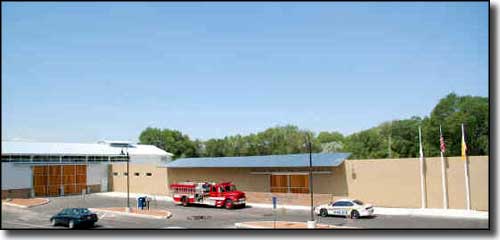
Bosque Farms, New Mexico

The Bosque Farms Village Offices
Bosque Farms is a rural village on the Camino Real, just outside the southern boundary of the Isleta Pueblo Indian Reservation. Near the northern county line of Valencia County, Bosque Farms is part of the Albuquerque Metropolitan Statistical Area. The village is located down in the forested zone that lines the bottom of the Rio Grande Valley.
Bosque Farms was originally part of the Antonio Gutierrez and Joaquin Sedillo Land Grant of 1716. Nicolas Duran de Chaves bought the property in 1736 and then sold it to Clemente Gutierrez. The first settlement was on the banks of the Rio Grande, but a flood in 1739 moved the river 2 miles to the west and the area became known as Los Pinos. Francisco Xavier Chavez bought the land from the Gutierrez family in 1819 and his son, Jose Mariano Chavez moved to the area with his family, living in a large hacienda that his father had built. When Jose Mariano Chavez died, his wife Dolores held onto the property and eventually she remarried. Her new husband was Henry Connelly, a successful businessman from Virginia who was appointed Territorial Governor of New Mexico by Abraham Lincoln on September 4, 1861.
Connelly was governor when the Confederates began marching up the valley of the Rio Grande. Los Pinos was occupied by the Confederates in February, 1862. The main body of soldiers continued to the north until they were defeated by Union forces at the Battle of Glorieta in March, 1862. They retreated to the heavily fortified hacienda at Los Pinos but the Union forces arrived and began a heavy bombardment of the place, shortly forcing the Confederates to retreat across the Rio Grande to the area of present-day Los Lunas. The Confederates continued their retreat southward under cover of a huge sandstorm, and that was the end of the Civil War in New Mexico. However, Los Pinos did become a supply center for the Union Army's Indian fighters and Governor Connelly never did come back to reclaim it (he died from an accidental opiate overdose in 1866). Dolores then returned to the property and lived there (or close by) until she died in 1890.
From May to July of 1884, the Rio Grande flooded so badly the water was running above the tree tops in the Bosque and nearly all signs of human settlement in the lower valley were washed away. From then until the time of the WPA project, the Bosque was basically swamp land covered with trees.
The WPA project is what created what is now known as "Bosque Farms." In May, 1935, 42 families were chosen by lottery to move into the area and occupy 42 tracts of land that varied from 40 to 80 acres in size. The WPA funded the construction of drainage trenches, roads and 2-to-3 bedroom adobe homes for the settlers. When the new settlers started farming operations in 1937, they discovered that the soil in the area was quite alkaline and wouldn't support crops. By 1939, the federal government was making loans to the folks to turn their farming operations into dairy operations and since then, Bosque Farms has been the "Heart of the Rio Grande Dairy Land."
Bosque Farms was finally incorporated as a municipality in 1974.
Latitude: 34.8534°N
Longitude: -106.6993°W
Incorporated: 1974
Elevation: 4,865'
Education:
High School or Higher: 89.8%
Bachelor's Degree or Higher: 24.6%
Graduate or Professional Degree: 9.1%
2011 Cost of Living Index for Bosque Farms: 94.3
Estimated Median Household Income: $60,570
Estimated Median Home Value: $197,600
Median Resident Age: 40.7 Years
Major Industries:
Health Care, Construction, Professional Services, Lodging & Food Services, Educational Services, Finance & Insurance Services, Government, Real Estate Services, Computer & Electronics Products, Real Estate Services, Transportation Services
Unemployed (March 2011): 9.5%
Population Demographics: 2010
| Total Population | 3,904 |
| Males | 1,914 |
| Females | 1,990 |
| Population by Age | |
| Under 18 | 810 |
| 18 & over | 3,094 |
| 20-24 | 148 |
| 25-34 | 297 |
| 35-49 | 773 |
| 50-64 | 1,094 |
| 65 & over | 688 |
| Population by Ethnicity | |
| Hispanic or Latino | 1,463 |
| Non Hispanic or Latino | 2,441 |
| Population by Race | |
| White | 3,274 |
| African-American | 17 |
| Asian | 24 |
| Native American | 110 |
| Hawaiian or Pacific Islander | 0 |
| Other | 359 |
| Two or more | 120 |
